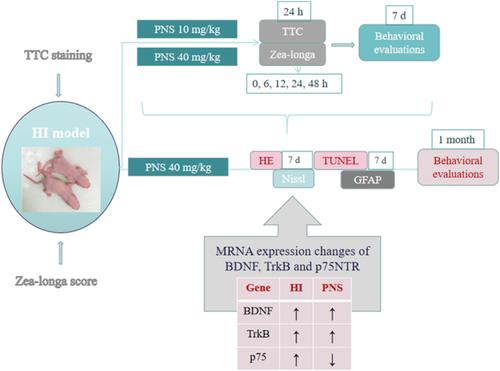当前位置:
X-MOL 学术
›
Eur. J. Neurosci.
›
论文详情
Our official English website, www.x-mol.net, welcomes your
feedback! (Note: you will need to create a separate account there.)
Panax notoginseng saponin attenuates the hypoxic–ischaemic injury in neonatal rats by regulating the expression of neurotrophin factors
European Journal of Neuroscience ( IF 2.7 ) Pub Date : 2021-08-17 , DOI: 10.1111/ejn.15428 Jin Huang 1 , Ya‐Xin Tan 1, 2 , Lu‐Lu Xue 3 , Ruo‐Lan Du 3 , Jun‐Jie Chen 4 , Li Chen 5 , Ting‐Ting Li 5 , Xue Bai 4 , Si‐Jin Yang 4 , Liu‐Lin Xiong 4 , Ting‐Hua Wang 3, 5
European Journal of Neuroscience ( IF 2.7 ) Pub Date : 2021-08-17 , DOI: 10.1111/ejn.15428 Jin Huang 1 , Ya‐Xin Tan 1, 2 , Lu‐Lu Xue 3 , Ruo‐Lan Du 3 , Jun‐Jie Chen 4 , Li Chen 5 , Ting‐Ting Li 5 , Xue Bai 4 , Si‐Jin Yang 4 , Liu‐Lin Xiong 4 , Ting‐Hua Wang 3, 5
Affiliation

|
Neonatal hypoxic–ischaemic (HI) injury is a serious complication of neonatal asphyxia and the leading cause of neonatal acute death and chronic neurological injury, and the effective therapeutic method is lacking to improve patients' outcomes. We reported in this study that panax notoginseng saponin (PNS) may provide a treatment option for HI. HI model was established using neonatal Sprague–Dawley rats and then intraperitoneally injected with different dosage of PNS, once a day for 7 days. Histological staining and behavioural evaluations were performed to elucidate the pathological changes and neurobehavioural variation after PNS treatment. We found PNS administration significantly reduced the infarct volume of brain tissues and improved the autonomous activities of neonatal rats, especially with higher dosage. PNS treatment at 40 mg/kg reduced neuronal damage, suppressed neuronal apoptosis and depressed astroglial reactive response. Moreover, the long-term cognitive and motor functions were also improved after PNS treatment at 40 mg/kg. Importantly, PNS treatment elevated the levels of BDNF and TrkB but decreased the expression of p75NTR both in the cortex and hippocampus of HI rats. The therapeutic efficacy of PNS might be correlated with PNS-activated BDNF/TrkB signalling and inactivation of p75NTR expression, providing a novel potential therapy for alleviating HI injury.
中文翻译:

三七总皂苷通过调节神经营养因子表达减轻新生大鼠缺氧缺血性损伤
新生儿缺氧缺血(HI)损伤是新生儿窒息的严重并发症,是新生儿急性死亡和慢性神经损伤的主要原因,目前缺乏有效的治疗方法来改善患者的预后。我们在这项研究中报告说,三七总皂苷 (PNS) 可能为 HI 提供一种治疗选择。用新生 Sprague-Dawley 大鼠建立 HI 模型,然后腹腔注射不同剂量的 PNS,每天 1 次,共 7 天。进行组织学染色和行为评估以阐明PNS治疗后的病理变化和神经行为变异。我们发现 PNS 给药显着减少了脑组织的梗塞体积并改善了新生大鼠的自主活动,尤其是在较高剂量下。40 mg/kg 的 PNS 治疗减少了神经元损伤,抑制了神经元凋亡并抑制了星形胶质细胞反应性反应。此外,在 40 mg/kg 的 PNS 治疗后,长期认知和运动功能也得到改善。重要的是,PNS 治疗提高了 BDNF 和 TrkB 的水平,但降低了 HI 大鼠皮层和海马中 p75NTR 的表达。PNS 的治疗功效可能与 PNS 激活的 BDNF/TrkB 信号传导和 p75NTR 表达的失活相关,为减轻 HI 损伤提供了一种新的潜在疗法。PNS 治疗提高了 BDNF 和 TrkB 的水平,但降低了 HI 大鼠皮层和海马中 p75NTR 的表达。PNS 的治疗功效可能与 PNS 激活的 BDNF/TrkB 信号传导和 p75NTR 表达的失活相关,为减轻 HI 损伤提供了一种新的潜在疗法。PNS 治疗提高了 BDNF 和 TrkB 的水平,但降低了 HI 大鼠皮层和海马中 p75NTR 的表达。PNS 的治疗功效可能与 PNS 激活的 BDNF/TrkB 信号传导和 p75NTR 表达的失活相关,为减轻 HI 损伤提供了一种新的潜在疗法。
更新日期:2021-09-21
中文翻译:

三七总皂苷通过调节神经营养因子表达减轻新生大鼠缺氧缺血性损伤
新生儿缺氧缺血(HI)损伤是新生儿窒息的严重并发症,是新生儿急性死亡和慢性神经损伤的主要原因,目前缺乏有效的治疗方法来改善患者的预后。我们在这项研究中报告说,三七总皂苷 (PNS) 可能为 HI 提供一种治疗选择。用新生 Sprague-Dawley 大鼠建立 HI 模型,然后腹腔注射不同剂量的 PNS,每天 1 次,共 7 天。进行组织学染色和行为评估以阐明PNS治疗后的病理变化和神经行为变异。我们发现 PNS 给药显着减少了脑组织的梗塞体积并改善了新生大鼠的自主活动,尤其是在较高剂量下。40 mg/kg 的 PNS 治疗减少了神经元损伤,抑制了神经元凋亡并抑制了星形胶质细胞反应性反应。此外,在 40 mg/kg 的 PNS 治疗后,长期认知和运动功能也得到改善。重要的是,PNS 治疗提高了 BDNF 和 TrkB 的水平,但降低了 HI 大鼠皮层和海马中 p75NTR 的表达。PNS 的治疗功效可能与 PNS 激活的 BDNF/TrkB 信号传导和 p75NTR 表达的失活相关,为减轻 HI 损伤提供了一种新的潜在疗法。PNS 治疗提高了 BDNF 和 TrkB 的水平,但降低了 HI 大鼠皮层和海马中 p75NTR 的表达。PNS 的治疗功效可能与 PNS 激活的 BDNF/TrkB 信号传导和 p75NTR 表达的失活相关,为减轻 HI 损伤提供了一种新的潜在疗法。PNS 治疗提高了 BDNF 和 TrkB 的水平,但降低了 HI 大鼠皮层和海马中 p75NTR 的表达。PNS 的治疗功效可能与 PNS 激活的 BDNF/TrkB 信号传导和 p75NTR 表达的失活相关,为减轻 HI 损伤提供了一种新的潜在疗法。











































 京公网安备 11010802027423号
京公网安备 11010802027423号